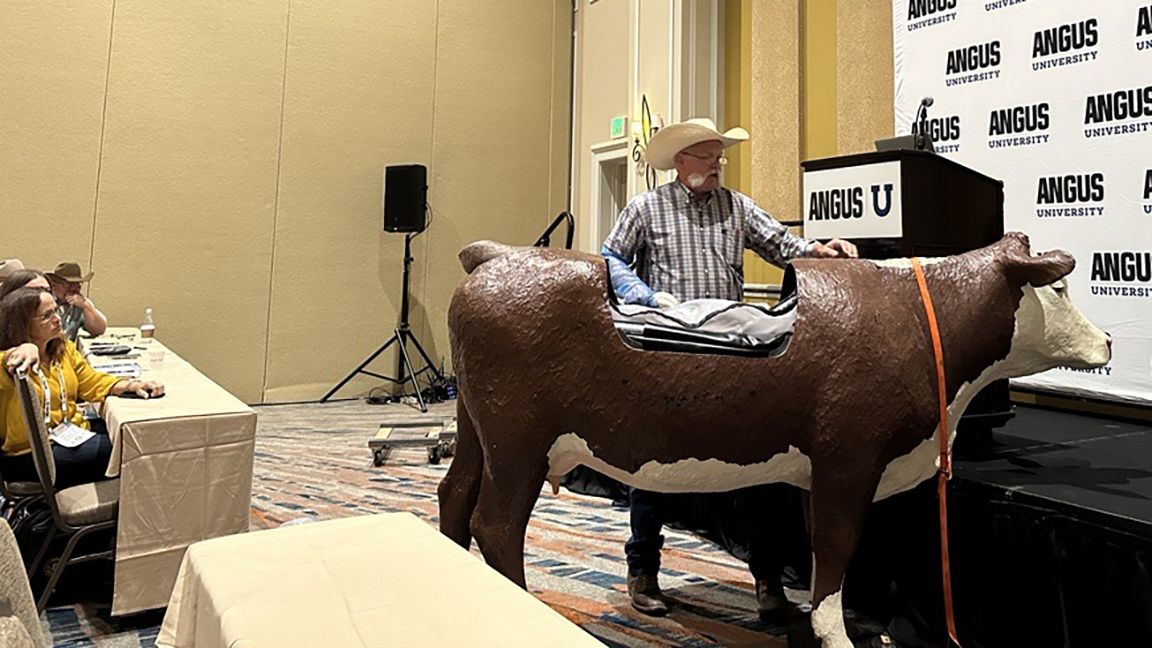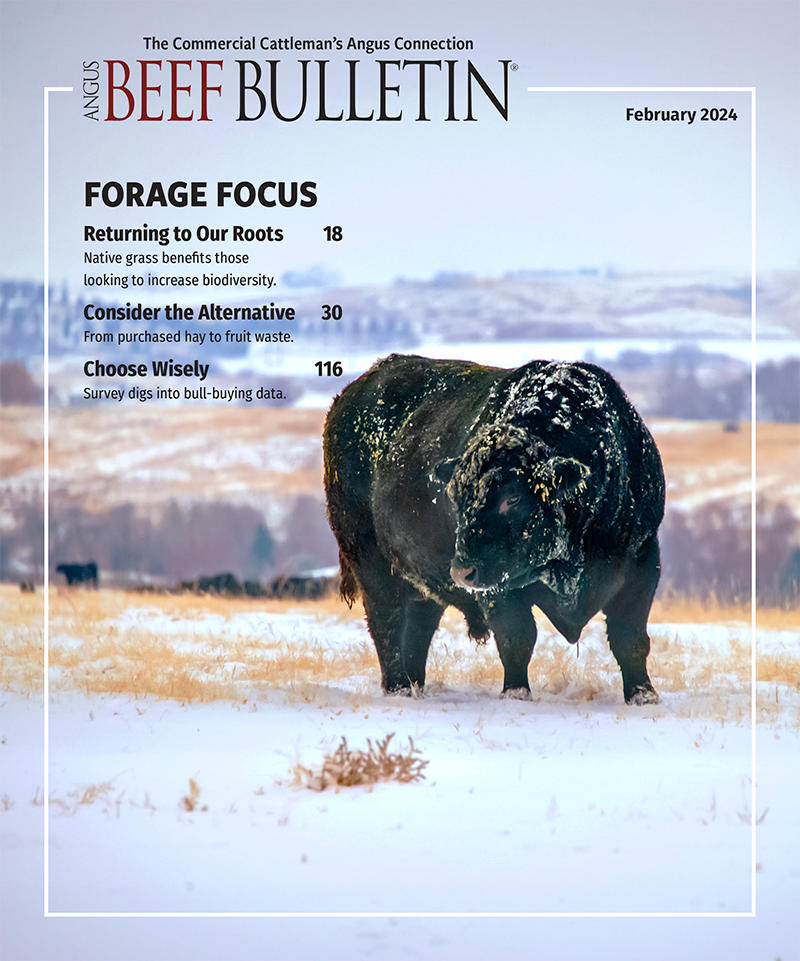
The University of Florida's Todd Thrift provided tips for assisting malpresentations at birth during an Angus University session at the 2023 Angus Convention in Orlando, Fla. [Photo by Shauna Hermel.]
Preventing Calving Difficulty in the Beef Herd
First-calf heifers are the most prone to dystocia.
As we move closer to spring, many ranchers are thinking ahead to calving season. This rewarding yet challenging time on the ranch comes with plenty of difficulties and worries, one of which is potential calving difficulties, or dystocia. Most operations expect to deal with dystocia, especially in heifers and younger cows, and have a contingency plan in place. However, the best treatment is always prevention.
Several factors can lead to dystocia. Some are more difficult to manage than others. This article briefly discusses a few of the factors producers can manage to deter calving difficulties.
Replacement heifers
The largest contributor to dystocia is the age of the cow. Two percent or less of calving problems occur in mature cows. Studies by the U.S. Meat Animal Research Center (USMARC) in Nebraska showed less than 5% of cows 5 years of age and older required calving assistance, while 54% of 2-year-old heifers experienced difficulty calving.
This proves what many already know: Heifers are usually the source of the trouble. Selecting the right heifers can help curtail that trouble.
When it comes to decreasing dystocia, using heifers with proven genetic merit is a good idea. This is often accomplished using the sire’s maternal expected progeny differences (EPDs), such as calving ease maternal (CEM). Genomic testing can also be used to predict heifer performance.
Pelvic measurements are another great tool in selecting heifers less likely to need calving assistance. However, a good pelvic measurement will not eliminate dystocia, as it is the relationship between pelvic size and calf weight that influences how easy delivery is. The benefits of a good pelvic area measurement can be negated by a calf that is too big.
It is also helpful to keep first-calf heifers close and, if possible, in a separate pasture from mature cows to monitor and assist if needed.
Sire selection
Many ranchers are aware certain bulls will yield bigger calves that are more likely to cause trouble. The bull’s breed is one selection criterion that allows ranchers to influence calf birth weight. Typically, British breeds like Angus and Hereford yield lighter-birth-weight calves than Continental breeds.
Looking at a bull’s EPDs allows a more fine-tuned approach to assess the expected difficulty his calves will pose. Birth weight EPD (BW), expressed in pounds (lb.), is a predictor of a sire’s ability to transmit birth weight to his progeny compared to that of other sires. Lower values indicate lower expected birth weights on average. Many producers utilize this EPD when selecting bulls to decrease dystocia, especially for first-calf heifers.
However, birth weight is not the only factor controlling calving ease. Many geneticists suggest focusing instead on the calving ease direct (CED) EPD, as this utilizes BW as well as other factors in its calculation. CED is expressed as a difference in percentage of unassisted births when a sire is bred to first-calf heifers. A higher CED value means that, when a sire is bred to first-calf heifers, a higher percentage of them would be expected to calve without intervention.
EPDs are a great tool for predicting how much calving difficulty to anticipate, especially when looking for a sire to pair with heifers.
Nutrition
Generally, pregnant 2-year-old heifers need about 9-13 pounds (lb.) of total digestible nutrients (TDN) per day. This is greater than a mature pregnant cow’s requirement of 8-12 lb. per day. Despite their smaller size, heifers are still developing themselves while also growing a calf.
A misconception persists that underfeeding cows and heifers during late pregnancy will lead to a smaller calf and lessen the likelihood of calving difficulty. This is not the case. Genetics are the predominant determinant of calf size. Underfeeding the mother can cause her to be weakened at calving, which increases the chance of dystocia.
Research shows that feeding the recommended level of TDN does lead to a slightly heavier birth weight than underfeeding, but it does not cause a greater instance of dystocia. Underfeeding will especially hinder 2-year-old heifers pregnant with their first calf by jeopardizing their skeletal growth and, therefore, their pelvic area. It can also decrease milk yield, increase calf scours and, most importantly, decrease pregnancy rates the following breeding season.
Research trials at the USDA Agricultural Research Service (ARS) research station in Miles City, Mont., show the relationship between dystocia and nutrition. Cows receiving a low plane of nutrition had higher percentages of dystocia than those on a high plane of nutrition, despite the group on a high plane of nutrition having a higher calf weight.
Overfeeding a heifer or cow to the point of obesity can lead to dystocia due to fat obstructing the pelvic canal and hampering her ability to physically strain, but this usually only occurs at a body condition score (BCS) of 8 or more. Obese cows are rarely a problem on Wyoming ranches, but both underfeeding and overfeeding can be monitored by keeping cows and heifers at a BCS 5-6. For help in determining BCS, the University of Wyoming Extension has published a three-step guide for recording body condition of range cows that can be found at www.wyoextension.org/publications/. This is a simple method of monitoring the nutrition of your herd as a whole.
The battle against dystocia in cattle requires a comprehensive approach, from strategic heifer and sire selection to good nutritional management. There are other factors that determine how likely it is we will have to pull a calf, but understanding how to manage the cow herd can improve our chances of easy births each spring.
Even the best management is not bulletproof against dystocia. Calving problems will still rear their head from time to time, so it is best to remain prepared to address the issue when it arises.
Editor’s note: Dagan Montgomery is an agriculture and natural resources extension educator in Sublette County, Wyo.



